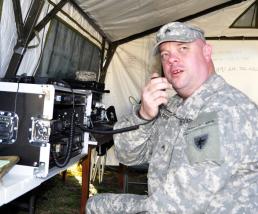Story By: Capt. Esperanza Meza
Posted: April 24, 2015
 Courtesy Photo
Courtesy Photo
Cpl. Christopher Parrish, 19th Regiment signal unit, Texas State Guard, conducts a radio exercise during part of a communications exercise conducted at California Crossing National Guard Armory in Dallas, Feb. 6-8, 2015. The exercise tested communications at great distances, operations management and how to provide support to the communities and officials involved during a natural disaster. (Texas State Guard photo by Capt. Esperanza Meza)
DALLAS - With natural disasters a constant threat, coordinating emergency response efforts is important to provide assistance and resources to communities.
The Texas State Guard, 19th Regiment signal unit conducted a three-day field communications exercise at the National Guard armory in Dallas, Feb. 6-8, 2015.
The exercise tested the unit’s ability to communicate over great distances, as well as across the local community to effectively manage operations and provide support to the communities and officials involved.
“During actual emergencies, there is a strong likelihood that the Texas State Guard will be working hand-in-hand to pass emergency radio traffic and digital messages back and forth,” said Maj. Glen Fowler, the regiment’s communications officer. “This means that establishing relationships in advance preparation is a good idea.”
Guardsmen worked with communications equipment powered by an 8,000 watt generator, emergency battery backups, and digital equipment that enabling high frequency messaging capabilities, for both near and remote locations, without the need for Internet access.
Guardsmen were able to connect with other state emergency resources without internet or phone communications, using mobile dual band very high frequency and ultra high frequency transceivers with vertical antennas and high frequency transceivers, something that is often needed in the event of a disaster, said Fowler.
The field exercise involved voice and digital modes, using high frequency and very high frequency transceivers, communicating with other military stations and Military Auxiliary Radio System volunteers across Texas and several other states.
MARS volunteers are amateur radio operators, licensed by the Federal Communications Commission and trained by the Army to operate as government auxiliary radio stations on the high frequency spectrum provided by the Department of Defense. The 19th Regiment has three Army MARS station licenses issued by Army MARS headquarters in Fort Huachuca, Arizona.
“The Texas State Guard has its own communication systems, but they need to be closely connected with other regional, state and national communications resources,” said Fowler. “Such interoperability helps to ensure that we can reliably communicate over great distances as well as just across a local community to be able to effectively manage our own operations as well as provide support to the communities and groups that we serve.”
The regiment’s signal team sent digital messages between Dallas and Austin using high frequency messaging modes, during the three-day exercise, and made numerous voice and digital communications connections with components all over the state.
Warrant Officer 1 Lew Thompson, Texas Army MARS Texas Military Forces liaison officer, worked one on one with the regiment during this exercise, providing additional technical support and remote communications test message reception and transmission.
“The exercise was used to further the communications capabilities and individual knowledge and skills of members of the signals unit and to show that long-range high frequency communication is a valuable resource for the Texas State Guard that should not be overlooked,” said Fowler. “It allows various components of the Texas Military Forces to be able to communicate state-wide to serve as the voice of command and carry out our important and diverse disaster and community support missions.”